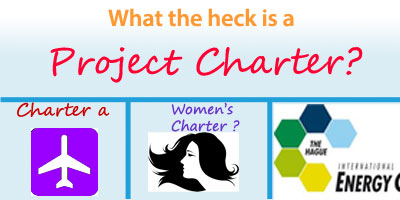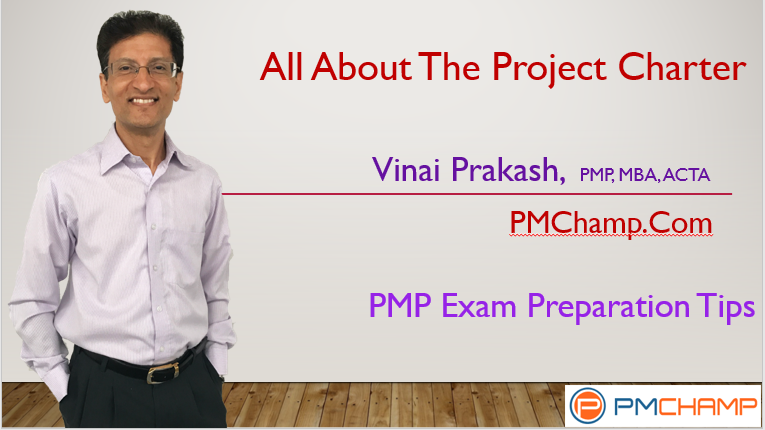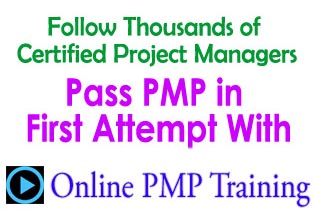Looking to Understand the Project Charter? Chances are high that you are studying for the PMP exam right now…

You see, most people have never heard of a Project Charter. They only come across this term when they begin to study for the PMP exam.
And since they have never heard nor seen this project charter document, they are completely clueless about what exactly is a project charter, what goes in the charter, who creates it, where do you get it from, and what’s the use, purpose, benefit of this Project Charter, just to name a few initial questions…
The Project Charter is an extremely important document for real projects, as well as the PMP exam. If you are serious about getting the PMP certification, you better study, understand and master the key concepts of the project charter thoroughly.
There will be at least 10+ questions about the Project Charter on the PMP exam. It will also help you in your current and future projects
What is a Project Charter?
A project charter is a high level document, which is created initially, as the project is mooted, to highlight the key need of the project – the objective, purpose of the project and its high level deliverables.
It also highlights the key risks, assumptions, constraints, estimated timeline, summary budget, key milestones, deliverables, project manager, key stakeholders etc.
The Project Charter is usually a short document – about one to three page long. If you go beyond that, you are probably writing an essay.
A project charter is supposed to provide a very short, high level overview of the project and its requirements, deliverables to provide a decent idea about the project to anyone who is interested.
It helps everyone on the project team to get clarity about the project, and have a common understanding.
According to PMBOK Guide, Sixth Edition:
Develop Project Charter is the process of developing a document that formally authorizes the existence of a project and provides the project manager with the authority to apply organizational resources to project activities.
The Need for a Project Charter
In the beginning, nobody on the project team may have a very clear idea about the project. Thus, people can get confused, and go in the wrong direction or may have misconceptions… wasting valuable time, money and resources.
The project charter is needed to provide initial, and continuous guidance to the project manager, and the entire project team about the scope, high lever deliverables and helps to set boundaries for the project.
It is written in broad terms, so that minor changes to the project can be handled easily, without having to change the charter.
A charter formally authorizes the existence of the project. If there is no project charter, or the project charter is not signed off, then officially there is no project. You may be working on some “ghost” project… Be careful!
The project charter also names the Project Manager, and their authority on the project clearly. This enables the project manager to expend the money, hire resources, or get the functional managers to allocate resources to this project.
Who Creates the Project Charter?
The project charter is ideally created by the project initiator – the person who came up with the initial idea for the project.
The initiator may then find someone in the organization to sponsor the project, and get the job done. In some cases, the initiator will delegate the task of writing the project charter to the project sponsor.
The sponsor is the person who provides time, money, resources to the project manager to do the project. And most of the time, the project sponsor will then appoint a project manager to actually do the project, and may even delegate the task of writing down the project’s charter document to the newly appointed project manager.
It is even recommended by the PMBOK Guide, Sixth edition that the actual project manager should participate in the development of the project charter to obtain a foundational understanding of the projects’ requirements in detail.
Keep in mind that although the project manager may study the project requirements, risks, assumptions and then write them down in the project charter document, the project manager is not the one to sign the project charter. But then, who signs it anyway?
Who Signs the Project Charter?
It is usually the Project Sponsor who signs the Project Charter. The project manager CAN NOT sign the project charter, even though the project manager might have created the document.
After all, you can not appoint yourself to be the project manager… meaning you can’t sign your own appointment letter. And you can’t authorize yourself to do any project on the organization’s behalf.
Generally speaking, anyone above the level of the project manager can sign the project charter. This means that it could be Program manager, Portfolio manager, Project Management Office (PMO), Senior managers, Directors and CXOs (CEO, CIO, CTO, COO level people), in their capacity as the Project Initiator or Project Sponsor.
However, for the PMP exam perspective, remember that it is the “manager external to the project” who signs the project charter. Why does an external person has to sign the project charter. That’s because the manager external to the project is not going to run the project on their own, but will provide the budget, time, resources to the project manager.
It is considered ‘external’ because they are not involved in the day to day running of the project. They are better left to serve as the point of escalation for the project.
What Goes Inside the Project Charter?
The project charter consists of a high level description of the Project. Some of the commonly used sections of a project charter are:
- Project Need / Opportunity / Justification for the Project
- Cost Benefit Analysis
- Project Objectives
- Key Stakeholders
- High Level Risks
- High Level Constraints / Boundaries
- High Level Assumptions
- Summary Budget
- Timeline, Key Milestones
- Success Criteria
- Project Manager and their Authority
Clarity in Project Objectives inside the Charter
Even though the project charter is a short document, it should not skimp on clarity and quality. The objectives should be S.M.A.R.T – Specific, Measurable, Acceptable, Realistic and Time Bound.
Don’t start a project to just “improve customer satisfaction”, or “increase topline revenue”, or “increase sales”, or “build better relationships with the customer” or “build a high speed train network”.
Such project objectives are very broad and open ended. You will never know whether you have achieved the objectives or not. And if you believe that you have achieved them, it is not necessary that your project sponsor or client will agree to it as well
Develop Project Charter Process
Of the 47 processes in the PMBOK Guide, Sixth Edition (applicable for PMP exam starting from July 2013 onwards), the Develop Project Charter in the first listed process.
It belongs to the Initiating process group, and the Integration Management Knowledge Area. Both are considered to be important, as well as difficult for the PMP exam.
The Develop Project Charter it is an extremely significant process in real life projects, as well as for the PMP exam. You see, it is one of the two process in Initiating. And 13% questions come from the Initiating process group (See PMP Exam Question Distribution Chart here). So of the 26 questions from Initiating, about 13 are going to be about this Project Charter process!
ITTOs for the Project Charter
Many people dread the Inputs, Tools & Techniques, and Outputs (ITTO) questions on the PMP exam. However, it is not really required to memorize the ITTOs. You can gain a better understanding of the ITTOs from this method I wrote about quite some time back, and has been extremely popular on the PMCHAMP blog.
Let’s understand the ITTOs for the Develop Project Charter process, in detail.
Inputs to Developing a Project Charter

Thinking logically, what would a project manager need to create a project charter? You would need the initial documents that came with the job.
Note that there are Five named inputs. This does not mean that all the five must always be present, or must always be used.
If you did not receive a SOW, then you can still proceed on the basis of the remaining documents, and start a fact finding mission to fill in the missing information.
- Statement of Work (SOW): The statement of work is generally provided to you by the client if the project is actually a contract/sub-contract from a prime contractor, or it could be part of the client’s requirements documentation provided to you to bid for the job.The SOW actually describes, in detail, what is the work required to be done.It could be high level, or in detail… it depends from project to project, and client to client.There are several templates for good SOWs. See the Templates section for some starter ideas, if you are creating a SOW for your project.However, for the PMP exam, the SOW is an input. This means it is prepared by someone else, and we have to use it, if available, for creating the Project Charter.
- Business Case: A business case is used to justify the ROI, Cost Benefit Analysis of undertaking the project.It talks about the opportunity, and its pros, cons, any mathematical calculations to justify the project, and projects of the overall benefit – in qualitative and/or quantitative figures.If there is a real business case to do the project, then only it should be undertaken.However, people always have pet projects, and the ROI calculations may not have been really done.If a business case is provided, the project manager can get an idea about the Cost, Opportunity, PV, NPV, IRR, Sunk Cost, Payback period etc. and understand the financials behind the project.
- Agreements or Contracts: This project could have come about from an Agreement, Contract, PO, Proposal being accepted by the customer. It could be written or verbal (usually if the project is internal).This agreement or contract between your client and you may have the timeline, budget, high level requirements, proposed approach, any specific terms and conditions, financials, milestones, etc. listed, and since it is a contract, you will be bound by the terms and conditions and will have to adhere to them.Contracts are legally binding, so take note of the fine print in contracts. And for external clients, it better be in writing.
- Enterprise Environmental Factors: The environment is not under our direct control. The weather, state, situations, office politics, government policies, country politics are all beyond us.We have to live with them… whether we like them or not.Similarly, there are environmental factors within the company (enterprise), which we have to live with – for example the organizational structure, the company’s risk profile, stakeholder’s risk tolerance, their approach to quality, percentage of time & attention spent on testing, project management approach, presence or absence of a PMO, project management software used or not used within the company etc. which are beyond us.It is important to understand the political landscape, the company culture and then plan your project within keeping the internal environmental factors safe.
- Organizational Process Assets: Every organization has its own internal policies, procedures, checklists, templates, as well as archives of past project documents.We must understand these internal policies, procedures (transfer policy, travel policy, salary advance procedure), procurement procedures, preferred vendors list, policy about 3 quotations, selecting the cheapest or best value quotation and then we can enhance them, tweak them to suit our project.As long as you work within these policies, and tweak them to suit your project, in accordance with the Sponsor and PMO, we are in good hands.In some cases, the project manager may not have enough experience, or may need more information about any aspect of the project.It is best to approach the PMO for more information in such cases.It may be the project manager’s first project, but most likely it is not the first project for the organization.You can go to the PMO, and ask them to browse through the project archive library, to see the documentation of past projects, and see how they allocated time, resources, handled risk, quality management plans etc. for past projects.You can learn a lot from these documents.Look at their lessons learned, issue logs, and what they did right or wrong. Learn from it, use it, adapt it!This is one of the smartest moves to accelerate your learning. Why make the same mistakes again when you can learn from the mistakes of others?
Tools & Techniques to Develop a Project Charter
-

Project Charter – Tools & Techniques Expert Judgment: This is not the project manager’s judgment… rather, it is the subject matter experts (SME) who can provide the best ways to gather information and come up with a solid, robust, flexible and workable, achievable project charter.
If you do not have the expertise in-house, you can hire an external consultant to do the task. Experts are generally available, but you may have to find them within the company, with the help of your sponsor or PMO.
- Facilitation Techniques: This second technique is where you call for meetings with the stakeholders, sponsors, client and key people who can provide clarity on the scope, project objectives, inclusions, exclusions, management approach etc. This will aid in the creation of the Project Charter.
Output of the Develop Project Charter Process
 Of course, the Completed Project Charter! What else did you expect?
Of course, the Completed Project Charter! What else did you expect?
Just remember that the charter is a high level document – that’s because in the early stages of the project, more detail is generally not available. And we want to keep the project charter in broad terms so that it does not have to change often.
It must be detailed enough to be able to guide us in terms of direction, scope, timeline, budget, risk, stakeholders so that the project manager can use this document and get started with the project planning in earnest.
Can The Project Charter Be Changed After it is Signed-off?
Any document on a project can be changed. The only requirement is that all changes must be reviewed, analyzed for impact on the triple constraints (Time, Cost, Scope, as well as Risk, Quality, Resources etc.), and formally approved by the relevant authorities.
Generally speaking, the Project Manager can approve any changes to the project, provided he/she has been awarded this authority.
But since the project charter is signed by the Project Sponsor (or any other manager external to the project – generally senior to the project manager), any changes to the project charter should also be approved by the Sponsor or the Change Control Board (CCB) appointed by the Sponsor.
Changes to the charter are never approved by the project manager. Remember this tip for the PMP exam!
This is to ensure that the integrity & sanctity of the project charter is maintained, and anyone is not allowed to change the charter at any time, just because they think a change is important.
It is the Project Sponsor’s responsibility to guard the Project Charter against any unauthorized or unapproved changes.
Template of a Project Charter

Although PMI or the PMBOK Guide will never publish a template for the charter, there are several templates available on the Internet.
I have used different formats for different projects, based on the company’s existing policies and forms.
However, you can use the sections above, or use some of these templates as a starting point for your projects. Use them, tweak them to suit your needs. After all, these are just guidelines, not a rule book. So go ahead and use it for your best advantage.
- PMCHAMP Project Charter Template
- Project Agency Templates
- Best Books on Project Charter
- CDC Project Charter
Benefits of the Project Charter
There are several extremely useful and essential benefits of having a project charter on your project.
- The key benefit of this process is a well-defined project start and project boundaries, project manager’s name & authority, key budget, timelines, risks etc.
- Creation of a formal record of the project.
- A direct way for senior management to formally accept and commit to the project
- Provides clarity to the project manager and the team about the end result, the end deliverable of the project. In the event of any confusion, you can always refer to the project charter for direction.
- This eliminates the need to go to the project sponsor for simple clarifications.
- Also, since it is a written document, and available to all, it serves as a common, single version of truth.This avoid different people from having different impressions about the project at different times.
How to Prepare for Project Charter Questions on the PMP Exam
You must master the art and science of answering PMP questions. This can only come when you have a strong foundation in Project Management fundamentals, create a good PMP Study plan & follow it, and you practice a number of PMP exam styled questions.
It is best to go for a good quality Online PMP Exam Preparation Coaching workshop, or attend one face to face. I prefer the online option, because you can study anytime, anywhere, and in small bytes of available time.
A face to face training is also good, but is often crammed in a short span of 4-5 days, and leads to information overload… which hinders memory retention.
Take a step by step, methodical, proven PMP exam prep training like PMCHAMP online training. It has helped thousands of project managers achieve the PMP certification within 6-8 weeks.
Resources for Practicing for the PMP Exam
There are over a 100 posts on the PMCHAMP blog, all focusing on helping you prepare and get ready for the PMP exam. Browse through them. Take notes, practice and benefit. I am highlighting a few that you will find useful immediately.
- PMP Strategy: How to answer PMP Questions
- 11 Things to Note For the PMP exam
- How to Answer PMP Questions
- How to Pick The Right Answer When All Choices Seem Correct in PMP exam [Video Lesson]
- Practice on over 1800 questions for the PMP exam
Conclusion:
The project charter is an extremely important document for any project, and for the PMP exam too
Study it well, prepare for the PMP exam methodically, stratigically, and be ready to ace the test in your First attempt!
Cheers,
Vinai Prakash, PMP






Thanks,prakash, well explained, helpful
Glad you liked it Dr. Rao. I try to help PMP aspirants as much as possible.
There is need to focus on Statistical Metods in PMP
Do you need help with any particular model – like Pareto Principle (80-20 Rule), or PERT, or corelation and regression? Let me know and I could write a future article on it… Thanks.
Hi Vinay,
Thanks for sharing overall view about project charter. It’s well explained in proper manner and one can easily understand. Very much helpful for everyone who are preparing for PMP examination or who are working in organization for project or program management.
Appreciate..